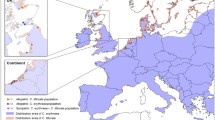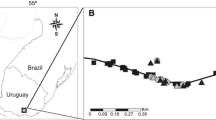Abstract
Biosystematic studies addressing mechanisms of speciation in widespread, phenotypically variable Neotropical plant taxa are scarce. In Viruá National Park, Roraima State, Brazil, we demonstrate that nine phenotypic variables measured from sympatric populations of two varieties within the Humiria balsamifera complex (Humiriaceae) are sharply discontinuous for both vegetative and floral characters. However, these differences were not explained by either phenological separation in anthesis, suppressed reproductive success in experimental inter-varietal crosses, or pollinator preferences, suggesting that pre-zygotic reproductive mechanisms do not contribute to the demonstrable phenotypic differences. Post-zygotic barriers such as reduced germination success in crosses, balancing selection at fine scales, or historical factors such as recent contact among formally isolated populations may account for the maintenance of phenotypic variation among these sympatric varieties. Future studies relating genetic structure with phenotypic variation may shed light on the mechanisms which promote and maintain large Neotropical species complexes such as in this case.






Similar content being viewed by others
References
Almeida LM, Ribeiro-Costa CS, Marinoni L (1998) Manual de coleta, conservação, montagem e identificação de insetos. Ribeirão Preto, Ed Holos
Anderson GJ, Hill JD (2002) Many to flower, few to fruit: the reproductive biology of Hamamelis virginiana (Hamamelidaceae. Abstr Bot Soc Amer 89:67–78. doi:10.3732/ajb.89.1.67
Augspurger CK (1985) Flowering synchrony of neotropical plants. In: D’Arcy WG, Correa MD (eds) The botany and natural history of Panama. Missouri Botanical Garden, Saint Louis, pp 235–243
Bacon CD, McKenna MJ, Simmons MP, Wagner WL (2012) Evaluating multiple criteria for species delimitation: an empirical example using Hawaiian palms (Arecaceae). BMC Evol Biol 12:2–40. doi:10.1186/1471-2148-12-23
Barrett SCH (2011) Understanding plant reproductive diversity. Abr Trans Philos Soc Roy Londres Bot 365:99–109. doi:10.1098/rspb.2013.0913
Bawa KS, Ashton PS, Primack RB, Terborgh J, Nor SM, Ng FSP, Hadley M (1989) Reproductive ecology of tropical forest plants: Research insights and management implications. IUBS News Magazine, vol 21 (Special Issue)
Bencke CSC, Morellato LP (2002a) Comparação de dois métodos de avaliação da fenologia de plantas, sua interpretação e representação. Revista Brasil Bot 25:269–275. doi:10.1590/S0100-84042009000200016
Bencke CSC, Morellato LP (2002b) Estudo comparativo da fenologia de nove espécies arbóreas em três tipos de floresta atlântica no sudeste do Brasil. Revista Brasil Bot 25:237–248. doi:10.1590/S0100-84042009000200018
Bove CP (1997) Phylogenetic analysis of Humiriaceae with notes on the Monophyly of Ixonanthaceae. J Computat Biol 2(1):19–24
Brasil (1975) Ministério das Minas e Energia. Projeto RADAM BRASIL. Levantamento dos Recursos Naturais. Folha NA. 20 Boa Vista e parte das Folhas NA-21 Tumuqumaque, NB–20 Roraima e NB–21, Rio de Janeiro, v8
Brewbaker JL (1957) Pollen cytology and self-incompatibility systems in plants. J Heredity 48:271–277
Brock T (2006) Prezygotic barriers to gene flow between Taraxacum ceratophorum and the invasive Taraxacum officinale (Asteraceae). Oecologia 161:241–251. doi:10.1007/s00442-009-1383-0
Bullock SH (1985) Breeding systems in the flora of a tropical deciduous forest in Mexico. Biotropica 7(4):287–301
Coyne J (1994) Ernest Mayr and the origin of species. Annual Rev Ecol Evol Syst 48:19–30. doi:10.2307/2409999
Coyne JA, Orr HA (2004) Speciation. Sinauer Associates, Sunderland, MA
Cruden RW, Hermann SM (1983) Studying nectar? Some observations and art. In: Bentley B, Elias T (eds) The biology of nectaries. Columbia University Press, New York, pp 223–242
Cuatrecasas J (1961) A taxonomic revision of the Humiriaceae. Contr US Natl Herb 35:25–214
Cuatrecasas J, Huber O (1999) Humiriaceae. In: Berry PE, Yatskievych P, Holst BK (eds) Flora of the Venezuelan Guayana, Eriocaulaceae-Lentibulariceae. Missouri Botanical Garden Press, St. Louis, pp 623–641
Dafni A, Maués MM (1998) A rapid and simple procedure to determine stigma receptivity. Sexual Pl Reprod 11:177–180. doi:10.1007/s004970050138
Daïnou K et al (2012) Phenological patterns in a natural population of a tropical timber tree species, Milicia Excelsa (Moraceae): evidence of isolation by time and its interaction with feeding strategies of dispersers. Amer J Bot 99:1453–1463. doi:10.3732/ajb.1200147
Dell’Olivo A, Hoballah ME, Gübitz T, Kuhlemeier C (2011) Isolation barriers between Petunia axillaris and Petunia integrifolia (Solanaceae). Evolution 65:1979–1991. doi:10.1111/j.1558-5646.2011.01279.x
Esteves SM, Vicentini A (2013) Cryptic species in Pagamea coriacea sensu lato (Rubiaceae): evidence from morphology, ecology and reproductive behavior in a sympatric context. Acta Amazon 43:415–428. doi:10.1590/S0044-59672013000400003
Fournier LA (1974) Un método cuantitativo para la medición de características fenológicas en árboles. AIBDA Bol Espec 24:422–423
Garrison BA, Koenig WD, Knops MH (2008) Spatial synchrony and temporal patterns in acorn production of California black oaks. Proceedings of the sixth symposium on oak woodlands: ecology and management. Pacific Southwest Research Station, Albany, USA
Gentry A (1974) A flowering phenology and diversity in Bignoniaceae. Biotropica 6:64–68
Gertz O (1938) Ueber die Verbreitung des Anthochlors bei den Compositen. Förh Kungl Fysiogr Sällsk Lund 8:62–70
Grant V (1981) Plant speciation. Columbia University Press, New York
Grant V (1994) Modes and origins of mechanical and ethological isolation in angiosperms. Proc Natl Acad Sci USA 91:3–10
Gribel R, Ferreira CAC, Coelho LS, Santos JL, Ramos JF, Silva KAF (2009) Vegetação do Parque Nacional do Viruá-RR. Relatório para ICMBio, Roraima, Brasil
Herrera F, Manchester SR, Jamarillo C, MacFadden B, Caminhat-Silva SA (2010) Phytogeographic history and phylogeny of the Humiriaceae. Int J Pl Sci 171:1–18. doi:10.1086/651229
Hirao AS, Kudo G (2008) The effect of segregation of flowering time on fine-scale spatial genetic structure in an alpine-snowbed herb Primula cuneifolia. Heredity 100:424–430. doi:10.1038/hdy.2008.1
Irwin RE, Adler LS, Brody AK (2004) The dual role of floral traits: pollinator attraction and plant defence. Ecology 85:1503–1511. doi:10.1890/03-0390
Kay KM (2006) Reproductive isolation between two closely related hummingbird-pollinated neotropical gingers. Evolution 60:538–552. doi:10.1554/05-339.1
Kearns CA, Inouye DW (1993) Techniques for pollination biologists. University Press of Colorado, Niwot
Kellogg EA (1990) Variation and species limits in agamospermous grasses. Syst Bot 15:112–123. doi:10.2307/2419021
Kennedy CM et al (2013) A global quantitative synthesis of local and landscape effects on wild bee pollinators in agroecosystems. Ecol Lett 16:1–16. doi:10.1111/ele.12082
Kephart S, Theiss K (2004) Pollinator-mediated isolation in sympatric milkweeds (Aclespias): do flo-ral morphology and insect behavior influence species boundaries? New Phytol 161:265–277. doi:10.1046/j.1469-8137.2003.00956.x
Kottek M, Grieser J, Beck C, Rudolf B, Rubel F (2006) World map of the Köppen-Geiger climate classification updated. Meteorol Z 15:259–263. doi:10.1127/0941-2948/2006/0130
Levin DA (1971) The origin of reproductive isolating mechanisms in flowering plants. Taxon 20:91–113
Mace GM (2004) The role of taxonomy in species conservation. Abr Trans Philos Soc Roy Londres Bot 359:711–719. doi:10.1098/rstb.2003.1454
Matsumoto T, Yasumoto AA, Nitta K, Yahara T, Tachida H (2013) Difference in flowering time as an isolating barrier. J Theor Biol 317:161–167. doi:10.1016/j.jtbi.2012.10.001
Mayr E (1992) A local flora and the biological species concept. Amer J Bot 79:222–238
McPeek MA, Gavrilets S (2006) The evolution of female preferences: differentiation from species with promiscuous males can promote speciation. Evolution 60:1967–1980. doi:10.1111/j.0014-3820.2006.tb01835.x
Medeiros H, Amorim AMA, Holanda ASS (2014) Humiriaceae. Lista de Espécies da Flora do Brasil. Jardim Botânico do Rio de Janeiro. http://floradobrasil.jbrj.gov.br/jabot/floradobrasil/FB84081. Accessed June 2014
Monteiro LR, Furness RW (1998) Speciation through temporal segregation of Madeiran storm petrel (Oceanodroma castro) populations in the Azores? Abr Trans Philos Soc Roy Londres Bot B 353:945–953
Morellato LPC, Leitão-Filho HF (1990) Estratégias fenológicas de espécies arbóreas em floresta mesófila na Serra do Japi, Jundiaí, SP. Revista Brasil Bot 50:163–173
Morellato LPC, Rodrigues RR, Leitão-Filho HF, Joly CA (1989) Estudo fenológico comparativo de espécies arbóreas de floresta de altitude e floresta mesófila semidecídua na Serra do Japi, Jundiaí, SP. Revista Brasil Bot 12:85–98. doi:10.1590/S0100-84042002000200012
Morrison DA, McDonald M, Bankoff P, Quirico P (1994) Reproductive isolation mechanisms among four closely-related species of Conospermum (Proteaceae). Bot J Linn Soc 116:13–31. doi:10.1111/j.1095-8339.1994.tb00419.x
Nosil P (2008) Speciation with gene flow could be common. Molec Ecol 17:2258–2275. doi:10.1111/j.1365-294X.2008.03715.x
Pansarin ER, Amaral MCE (2006) Biologia reprodutiva e polinização de duas espécies de Polystachya Hook. no Sudeste do Brasil: evidência de pseudocleistogamia em Polystachyeae (Orchidaceae). Revista Brasil Bot 29:423–432. doi:10.1590/S0100-84042006000300009
Pascarela JB (2007) Mechanisms of prezygotic reproductive isolation between two sympatric species, Gelsemium rankinii and G. sempervirens (Gelsemiaceae), in the Southeastern United States. Amer J Bot 94:468–476. doi:10.3732/ajb.94.3.468
Phadnis N, Orr HA (2009) A single gene causes both male sterility and segregation distortion in Drosophila hybrids. Science 323:376–379. doi:10.1126/science.1163934
Proctor M, Yeo P, Lack A (1996) The natural history of pollination. British Wildlife Publishing, Britain
Ramírez N, Briceño H (2011) Reproductive phenology of 233 species from four herbaceous—shrubby communities in the Gran Sabana Plateau of Venezuela. AoB PLANTS 14:1–17. doi:10.1093/aobpla/plr014
Ramsey J, Bradshaw HD Jr, Schemske DW (2003) Components of reproductive isolation between the monkey flowers Mimulus lewisii and M. cardinalis (Phrymaceae). Evolution 57:1520–1534. doi:10.1111/j.0014-3820.2003.tb00360.x
Rathcke B, Lacey EP (1985) Phenological patterns of terrestrial plants. Annual Rev Ecol Evol Syst 16:179–214. doi:10.1146/annurev.es.16.110185.001143
Richards AJ (1997) Plant breeding systems. Chapman and Hall, London
Rieseberg LH, Willis JH (2007) Plant Speciation. Science 317:910–914. doi:10.1126/science.1137729
Schaefer CEGR, Mendonça BAF, Fernandes Filho EI (2009) Geoambientes e Paisagens do Parque Nacional do Viruá–RR: esboço de integração da geomorfologia, climatologia, solos, hidrologia e ecologia (Zoneamento Preliminar). Relatório para ICMBio, Roraima, Brasil
Schemske DW (2010) Adaptation and the origin of species. Amer Naturalist 176:4–25. doi:10.1086/657060
Schemske DW, Bierzychudek P (2001) Evolution of flower color in the desert annual Linanthus parryae: Wright revisited. Evolution 55:1269–1282. doi:10.1111/j.1558-5646.2007.00219.x
Schifino-Wittmann MT, Dall’Agnol M (2002) Auto-incompatibilidade em plantas. Ciência Rural 32:1083–1090. doi:10.1590/S0103-84782002000600027
Schwade MRM, Neto RGS, Webber A (in press) Biologia reprodutiva de três espécies de Retiniphyllum Bompl. (Rubiaceae) em campinaranas na Amazonia central. Acta Amazon
Storti EF, Braga PIS, Storti-Filho A (2011) Biologia reprodutiva de Cattleya eldorado, uma espécie de Orchidaceae das campinas amazônicas. Acta Amazon 41:361–368. doi:10.1590/S0044-59672011000300005
Sun HQ, Huang BQ, Yu XH, Kou Y, An DJ, Luo YB (2011) Reproductive isolation and pollination success of rewarding Galearis diantha and non-rewarding Ponerorchis chusua (Orchidaceae). Ann Bot (Oxford) 107:39–47. doi:10.1093/aob/mcq210
Sutherland S, Delph L (1984) On the importance of male fitness in plants: patterns of fruit-set. Ecology 65:1093–1104. doi:10.2307/1938317
R Development Core Team (2008) R: A language and environment for statistical computing. R Foundation for Statistical Computing, Vienna, Austria, ISBN 3-900051-07-0. http://www.R-project.org. Accessed Jan 2013
Tokumoto Y, Itioka T, Ohkubo T, Tadauchi O, Nakagawa M (2013) Assemblage of flower visitors to Dillenia suffruticosa and possible negative effects of disturbances in Sarawak, Malaysia. Entomol Sci 16:144–152. doi:10.1111/ens.12018
Vázquez SPF, Webber AC (2010) Biologia floral e polinização de Casearia grandiflora, Casearia javitensis e Lindackeria paludosa (Flacourtiaceae) na região de Manaus, AM. Revista Brasil Bot 33:131–141. doi:10.1590/S0100-84042010000100012
Virillo CB, Ramo FN, Castro CC, Semir J (2007) Floral biology and breeding system of Psychotria tenuinervis Müll. Arg. (Rubiaceae) in the Atlantic rain forest, SE Brazil. Acta Bot Brasil 21:879–884. doi:10.1590/S0102-33062007000400012
Vogel S (1963) Duftdrüsen im Dienste der Bestäubung: Über Bau und Funktion der Osmophoren. Akad Wiss Lit Maiz Abh Math Naturwiss Klasse Jahrg 10:600–763
Weins D, Calvin CL, Wilson CA, Davern CI, Frank D, Seavey SR (1987) Reproductive success, spontaneous embryo abortion, and genetic load in flowering plants. Oecologia 71:501–509. doi:10.1007/BF00379288
Wendt T, Coser TS, Matallana G, Guilherme FAG (2008) An apparent lack of prezygotic reproductive isolation among 42 sympatric species of Bromeliaceae in southeastern Brazil. Pl Syst Evol 275:31–41. doi:10.1007/s00606-008-0054-7
Wurdack KJ, Davis CC (2009) Malpighiales phylogenetics: gaining ground on one of the most recalcitrant clades in the angiosperm tree of life. Amer J Bot 96(8):1551–1570. doi:10.3732/ajb.0800207
Acknowledgements
We are grateful to Brazil’s National Research Council (CNPq), Coordination for the Perfection of Graduate Level Students (CAPES), Graduate School for Botany at the National Institute for Amazonian Research (PPG-Bot/INPA). We especially are grateful to André Rech for his invaluable assistance in experimental design and reproductive Biology. CEZ was partly supported by Edital MCT/CNPq/MEC/CAPES (No. 52/2010-PROTAX) during the writing of this paper.
Author information
Authors and Affiliations
Corresponding author
Additional information
Handling editor: Ricarda Riina.
Rights and permissions
About this article
Cite this article
de Holanda, A.S.S., Vicentini, A., Hopkins, M.J.G. et al. Phenotypic differences are not explained by pre-zygotic reproductive barriers in sympatric varieties of the Humiria balsamifera complex (Humiriaceae). Plant Syst Evol 301, 1767–1779 (2015). https://doi.org/10.1007/s00606-014-1191-9
Received:
Accepted:
Published:
Issue Date:
DOI: https://doi.org/10.1007/s00606-014-1191-9




